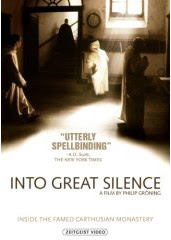 Die grosse Stille (Into Great Silence, 2005), directed by Philip Gröning (released on October 23, 2007) |
 René-Michel Slodtz, St. Bruno (recoiling from the episcopal miter and crozier), marble, 1744, Basilica di San Pietro, Rome |
In imitation of St. Bruno, the Carthusians live a semi-eremetical life, meaning that each choir monk lives in an enclosed and mostly self-sufficient hermitage, lined up in a row like little cottages. He lives in silence and isolation, for the most part celebrating the Divine Office and taking his meals alone in his cell. The community comes together for Mass daily and to sing the office, as well as eating a communal meal on Sundays and feast days. There are also lay brothers, whose daily routine is focused more on labor and who live in community. We see them in the movie, for example, walking down a long corridor and placing food or other necessities into each cell through a little door. An alluring feature of the DVD release is an hour-long excerpt from a Matins service at La Grande Chartreuse, the sound of chanting accompanied by visuals of the Latin texts being sung.
 "Fenced early in this cloistral round Of reverie, of shade, of prayer, How should we grow in other ground? How can we flower in foreign air? --Pass, banners, pass, and bugles, cease; And leave our desert to its peace!" -- Matthew Arnold, Stanzas from the Grande Chartreuse |
One of my favorite verses returns several times: "You have seduced me, Lord, and I let myself be seduced." That is how Jeremiah (Chapter 20) describes the beginning of his vocation from God, a deception, a seduction, that leads him to shout prophecies that cause him to be ridiculed. When he tries to fight against the calling and keep silent, however, "there came in my heart as a burning fire shut up in my bones, and I was wearied, not being able to bear it." The only personalization of the monastic narrative, which is by definition anonymous, is that, to a degree, Gröning follows two novices as they are admitted to the community, installed in a cell, and navigate their new life. He also includes several shots of the faces of monks, which show the range of ages from the young and healthy to the emaciated body of an aged and eerily radiant monk. What is striking is the happiness and joy that pervade the community, so contrary to popular misconceptions about monastic life. This is not a place of gloom but of light-filled solitude: when you see it, one understands that these men are planted in the right place, to paraphrase Matthew Arnold.
No comments:
Post a Comment